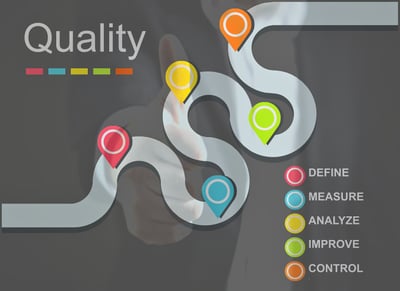 DMAIC (Define, Measure, Analyze, Improve, Control) is a data-driven, structured, customer-centric problem-solving methodology. Each phase builds on the last to arrive at practical solutions for challenging problems. Define tells you what to measure. Measure tells you what to analyze. Analyze tells you what to improve. And Improve tells you what to control.
DMAIC (Define, Measure, Analyze, Improve, Control) is a data-driven, structured, customer-centric problem-solving methodology. Each phase builds on the last to arrive at practical solutions for challenging problems. Define tells you what to measure. Measure tells you what to analyze. Analyze tells you what to improve. And Improve tells you what to control.
Each phase has particular objectives and is supported by a specific set of activities. Let's take a closer look at them.
Define
The Define phase is all about selecting high-impact opportunities for improvement and understanding what it means to be successful.
During this phase, the leaders will:
- Identify or validate the improvement opportunity
- Outline the scope of the project
- Develop the business process and critical customer requirements
- Document business opportunity
- Estimate project impact
- Identify stakeholders
- Form the team
- Create team charter
- Identify and map related business processes
Questions to ask include:
- Why are we talking about this problem?
- Where are we today?
- What are the potential advantages of change?
- What is outside the scope of this project?
- Who is impacted by the target process?
- What priority is assigned to this work?
It is tempting to truncate or skip this step, especially if it is believed that the problem is well understood, but that is a mistake. A clear definition of the project's scope is essential to keep the work focused and deliverables clear.
Measure
During the Measure phase, existing processes are documented, and a baseline is established. There are many ways to measure process results, including processing time, the number of defects, the number of steps in the process, distance traveled, and work units in progress. Now is the time to choose the handful of metrics that will be useful for this improvement opportunity.
Critical activities at this point include:
- Developing the methodology by which data will be collected to evaluate the success
- Identifying input, processes, and output indicators
- Gathering, plotting, and analyzing current state data
- Completing failure modes and effects analysis
Questions to ask include:
- How will we know that improvement has occurred?
- What is the most critical data to quantify?
- Are there factors that should determine when measurements are taken?
- How long do we need to gather baseline measurements?
Many types of charts and graphs can be helpful during the measurement phase. Control charts are among the most popular.
Analyze
The goal of the Analyze phase is to find and validate the root causes of business problems and ensure that improvement is focused on causes rather than symptoms.
To do this, you will:
- Develop a problem statement
- Complete a root cause verification analysis
- Implement process control
- Conduct regression analysis
- Design measurable improvement experiments
- Develop a plan for improvement
Questions to ask include:
- Are the proposed solutions targeted toward the root cause of the problem or symptoms?
- How will the proposed solutions solve the root cause issue?
- Are there any risks associated with the proposed change?
- Will the proposed changes impact other processes?
- Have all of the appropriate stakeholders been consulted?
One continuous improvement technique that can be enormously helpful at this phase is the 5 Whys problem-solving approach. You state the problem and then ask "Why?" until you reach the root cause. This usually takes about five cycles.
Improve
Once you reach the Improvement phase, it is time to determine precisely which steps will be taken and begin to roll out the changes that the analysis has prescribed.
The following activities are common:
- Determine expected solution benefits
- Develop revised process maps and plans
- Define a pilot solution and plan
- Communicate solutions to all stakeholders
Questions to ask include:
- Is there a way to test the proposed solution in a controlled manner?
- When is the best time to implement the improvement?
- Who will be responsible for each step of the project?
- How will the work be documented?
- Who needs to know about this change?
If the initial three phases of the cycle have been thoughtfully and thoroughly completed, the Improve phase is often the easiest. Because you understand the problem, its impact, and root cause, you can proceed with confidence as you implement positive change.
Control
The last stage's objective is to develop the monitoring processes and procedures that will ensure long-term success.
To do so:
- Verify reduction in failures due to the targeted root cause
- Determine if additional improvement is necessary to achieve the project goal
- Identify and document replication and standardization opportunities
- Update Standard Work documentation
- Integrate lessons learned
Questions to ask:
- Do we have the infrastructure in place to ensure the improvement is long-lasting?
- What is the plan for periodic assessment of measurable metrics?
- When should the process be reevaluated for potential additional improvements?
- Did the project reveal any other problems that should be addressed?
- Who can learn from our experience?
While it may feel like the project is over after the improvement is implemented, that's far from the case. Only if you take steps to maintain the progress will you have the opportunity to build from there, creeping ever closer to perfection.
Although it is most commonly associated with Six Sigma, DMAIC can be used as a standalone tool for process improvement. Close adherence to the process of DMAIC helps leaders and their teams ensure that improvement projects are organized, effective, and repeatable.



Add a Comment